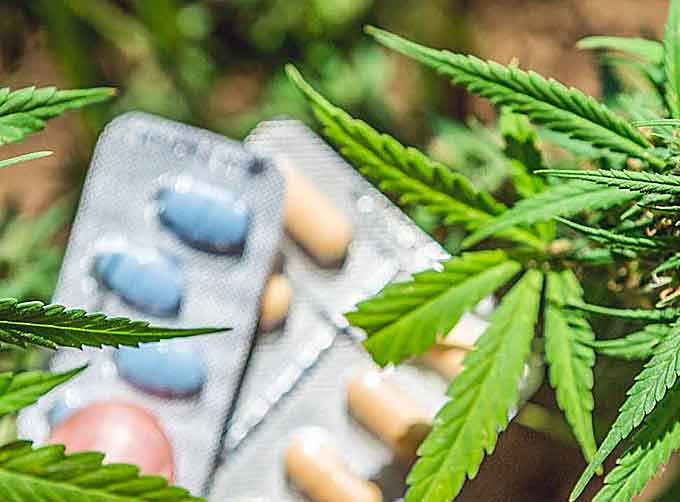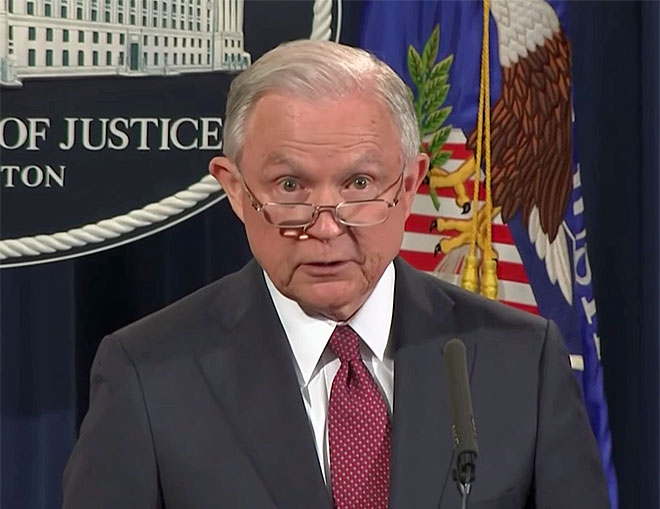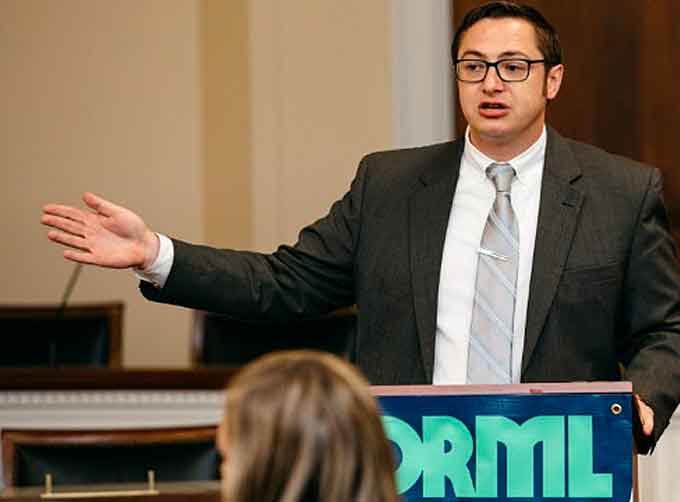
The Department of Justice (DOJ), and the U.S. Drug Enforcement Administration (DEA) have proposed a reduction for controlled substances that may be manufactured in the U.S. next year.
Consistent with President Trump’s “Safe Prescribing Plan” that seeks to “cut nationwide opioid prescription fills by one-third within three years,” the proposal decreases manufacturing quotas for the six most frequently misused opioids for 2019 by an average ten percent as compared to the 2018 amount.
(Learn More. U.S. President Donald Trump on Thursday again pressed U.S. Attorney General Jeff Sessions to sue drug companies over the nation’s ongoing opioids crisis. Courtesy of The Sun and YouTube. Posted on Aug 17, 2018.)
The Notice of Proposed Rulemaking marks the third straight year of proposed reductions, which help reduce the amount of drugs potentially diverted for trafficking and used to facilitate addiction.
On July 11, 2018, the Justice Department announced the DEA was issuing a final rule amending its regulations to improve the agency’s ability to consider the likelihood of whether a drug can be diverted for abuse when it sets annual opioid production limits.
The final rule also promotes greater involvement from state attorneys general, and this proposed reduction will be sent to those offices.
In setting the aggregate production quota, the DEA considers data from many sources, including:

- Estimates of the legitimate medical need from the Food and Drug Administration (FDA)
- Estimates of retail consumption based on prescriptions dispensed
- Manufacturers’ disposition history and forecasts
- Data from the DEA’s own internal system for tracking controlled substance transactions, and past quota histories
The DEA has proposed to reduce more commonly prescribed schedule II opioids, including oxycodone, hydrocodone, oxymorphone, hydromorphone, morphine, and fentanyl.
Ultimately, revised limits will encourage vigilance on the part of opioid manufacturers, help the DEA respond to the changing drug threat environment, and protect the American people from potential addictive drugs while ensuring that the country has enough opioids for legitimate medical, scientific, research, and industrial needs.
“The opioid epidemic that we are facing today is the worst drug crisis in American history,” said Attorney General Jeff Sessions.

“President Trump has set the ambitious goal of reducing opioid prescription rates by one-third in three years. We embrace that goal and are resolutely committed to reaching it.”
“According to the National Prescription Audit, we have already made significant progress in reducing prescription rates over the past year.”
“Cutting opioid production quotas by an average of ten percent next year will help us continue that progress and make it harder to divert these drugs for abuse.”
“The American people can be confident that federal law enforcement and the Trump administration are taking action to protect them from dangerous drugs.”
“These smarter limits bring us one big step closer to President Trump’s goal of finally ending this unprecedented crisis.”
“I congratulate Acting Administrator Uttam Dhillon and his team for taking action.”

“We’ve lost too many lives to the opioid epidemic and families and communities suffer tragic consequences every day,” said DEA Acting Administrator Uttam Dhillon.
“This significant drop in prescriptions by doctors and DEA’s production quota adjustment will continue to reduce the amount of drugs available for illicit diversion and abuse while ensuring that patients will continue to have access to proper medicine.”
Once the aggregate quota is set, the DEA allocates individual manufacturing and procurement quotas to those manufacturers that apply for them.
The DEA may revise a company’s quota at any time during the year if change is warranted due to increased or decreased sales or exports, new manufacturers entering the market, new product development, or product recalls.
When Congress passed the Controlled Substances Act, the quota system was intended to reduce or eliminate diversion from “legitimate channels of trade” by controlling the quantities of the basic ingredients needed for the manufacture of controlled substances.
The Proposed Aggregate Production Quotas (APQ) for cannabis and other drugs published in the Federal Register, “reflects the total amount of controlled substances necessary to meet the country’s medical, scientific, research, industrial, and export needs for the year and for the establishment and maintenance of reserve stocks,” according to the DEA.
(Learn More. Ann Marie shares her story as a mother who tragically lost her 22-year-old son to a prescription opioid overdose. Courtesy of the Centers for Disease Control and Prevention (CDC) and YouTube. Posted on Sep 25, 2017.)
The DEA establishes an APQ for more than 250 schedule I and II controlled substances annually.
In 2016, the Centers for Disease Control and Prevention (CDC) issued guidelines to practitioners recommending a reduction in the prescribing of opioid medications for chronic pain.
The DEA and its federal partners have increased efforts in the last several years to educate practitioners, pharmacists, manufacturers, distributors, and the public about the dangers associated with the misuse of opioid medications and the importance of proper prescribing.
To view the 2019 Aggregate Production Quota NPRM click here.
Learn More…
DEA Wants More Marijuana Grown And Fewer Opioids Produced In 2019. Really.

By Tom Angell, Forbes
The Drug Enforcement Administration (DEA) isn’t exactly known as big fan of marijuana.
But in a new Federal Register filing set to be published soon, the anti-drug agency is moving to more than quintuple the amount of cannabis that can legally be grown in the U.S. for research purposes—from roughly 1,000 pounds in 2018 to more than 5,400 pounds next year.
At the same time, DEA is also pushing to reduce the amount of certain opioid drugs—such as oxycodone, hydrocodone, morphine, fentanyl and others—that are produced in the U.S.
“We’ve lost too many lives to the opioid epidemic and families and communities suffer tragic consequences every day,” DEA Acting Administrator Uttam Dhillon said in a press release.
“This significant drop in prescriptions by doctors and DEA’s production quota adjustment will continue to reduce the amount of drugs available for illicit diversion and abuse while ensuring that patients will continue to have access to proper medicine.”
(Learn More. Opioid overdose emergency department visits rose 30% in all parts of the U.S. from July 2016 through September 2017. Courtesy of the Centers for Disease Control and Prevention (CDC) and YouTube. Posted on Mar 6, 2018.)
U.S. Attorney General Jeff Sessions, a longtime opponent of marijuana legalization, added that “the opioid epidemic that we are facing today is the worst drug crisis in American history… Cutting opioid production quotas by an average of ten percent next year will help us continue that progress and make it harder to divert these drugs for abuse.”
The proposed quotas for cannabis and other drugs “reflects the total amount of controlled substances necessary to meet the country’s medical, scientific, research, industrial, and export needs for the year and for the establishment and maintenance of reserve stocks,” DEA said.
The 2,450,000 grams of marijuana the narcotics agency wants grown in the country in 2019 is a significant bump up from the 443,680 grams the agency authorized for 2018.
In addition to the huge increase in marijuana cultivation, DEA is also proposing to allow production of 384,460 grams of tetrahydrocannabinols (THC) in 2019, the same amount the agency cleared for this year.
Since 1968, a farm that the University of Mississippi has maintained a monopoly on the production of cannabis that can legally be used for research in the U.S. But scientists have long complained that it is sometimes hard to get approvals to obtain marijuana from the facility and that its product is often of low quality.
(See NIDA TV interview with Dr. Mahmoud ElSohly who oversees the marijuana farm at the University of Mississippi under a National Institute on Drug Abuse (NIDA) contract. Dr. ElSohly describes the mission of the farm and the changing THC potency levels of confiscated marijuana. Courtesy of NIDA, University of Mississippi and YouTube. Posted on May 7, 2014.)
In response to these concerns, DEA moved in the waning months of the Obama administration to end the monopoly and create a process for the National Institute on Drug Abuse (NIDA) to license additional cultivators.
But while more than two dozen facilities have filed proposals to become licensed to legally grow marijuana for research, Sessions’ Justice Department has blocked DEA from acting on the applications.
Members of Congress have repeatedly pressed Sessions on the issue, during hearings and most recently in a letter signed last month by eight senators.
“Research and medical communities should have access to research-grade materials to answer questions around marijuana’s efficacy and potential impacts, both positive and adverse,” the lawmakers wrote.
“Finalizing the review of applications for marijuana manufacturing will assist in doing just that.”
During a Senate hearing last October, Sessions said that adding new facilities that could compete with the University of Mississippi would be “healthy.”


















